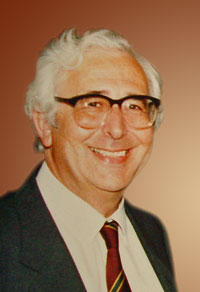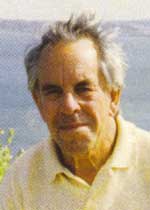|
BBCeng.info
Recollections of BBC engineering from 1922 to 1997 |
The British Broadcasting Corporation web site is: www.bbc.co.uk |
Research Department - Memory Lane
Charlie Sandbank

LIFE HISTORY OF PROFESSOR CHARLES P. SANDBANK FREEng. Bsc. DIC HonDUniv
FinstP FIET FRSA
Educated at Bromley Grammar School and London University
Professor Charles Sandbank started his long connection with Imperial College when he was sponsored by his employer STC to do a DIC in Electrical Engineering which included attendance at LSE where he widened his sphere of interests.
He started his career with STC where he developed some of the first semi-conductor integrated circuits to be produced in Europe. He later became head of the Electron Devices Laboratory at STL in Harlow and in 1968 became Manager of the STL Communications Division. He was responsible for the team that pioneered the use of Optical Fibres for communications and in 1976 built the world’s first wideband digital optical fibres communications system. At this time he was also concerned with establishing standards in a completely new field for aircraft navaids with safety critical, political and commercial implications.
In 1978 he took up the post of Head of Research and Development with the BBC Research Department where he was a breath of fresh air. ‘Call me Charlie’ he said when referred to as ‘Sir’. Whilst there he was instrumental in the setting up of the BBC Micro project, one of the earliest computers, and its introduction into schools throughout the country. He exploited Nicam Stereo sound for television which became the world’s first digital broadcasting system and realised the potential of HDTV. He became the first Chair of the EBU’s HDTV Committee. He was instrumental in the introduction of Digital Television and has written one of the seminal works on the subject. His generous personality and enthusiasm for projects was vital in persuading politicians and organisations to invest in new technologies and he developed the digital audio broadcast system DAB.
It is a little known fact that the reason drivers can continue to listen to BBC programmes as they travel through the Dartford Tunnel is because Sandbank was instrumental in persuading the BBC and the builders of the tunnel to work together in installing the necessary equipment.
As Chairman of the EBU New Systems and Services Committee he led the EBU’s preparation for contributions to Standards bodies. He played a major part in the work between the EBU and SMPTE leading to the CCIR Digital TV Production Standard Rec.601 on which most current TV production is based.
In 1988 Charlie became a Liveryman of the Worshipful Company of Scientific Instrument Makers.
After leaving the BBC Charlie became Broadcasting Technology Advisor to what was then The Department of Trade and Industry advising on radio standards, frequency bands and their standardisation, chairing international committees where he had a talent for getting agreement between members whilst remaining a popular contributor. Prof Sandbank was actively involved in international standards bodies such as the ITU and ETSI. He was a member of several academic advisory bodies. He had a high reputation in SMPTE of which he was a Fellow, RTS, BKSTS, EBU and ABU.
As founding Chairman of the ETSI JTC Charlie established the relationship with DVB which led to extensive worldwide acceptance of the European Digital TV standard. Charlie conceived the ‘Umbrella’ concept whereby the standards for terrestrial, satellite and cable all sit under a basic standard unlike the competing US standards for the three transmission media which are all different. This hindered their adoption compared with DVB which also had the benefit of a superior modulation method.
Charles attended, hosted or chaired UK Standardisation Co-ordination meetings to help establish UK policy and develop briefs for the UK response to papers from other administrations. He had regular discussions, gave and sought advice on standards issues with DTI, OFCOM and DCMS colleagues.
He had good relations with many people at all levels in the European Commission as well as professionals in Broadcasting, Manufacturing and Content Creation Industries throughout the world.
In 2001 he became founding co-chairman of the European Digital Cinema Forum lobbying government backed bodies, including the UK Film Council, to invest in electronic digital projectors for cinemas throughout the UK. He was enthusiastic about the development of 3D Cinema.
From 1982 until his death he was the Royal Academy Visiting Professor in the Principles of Information Systems Design at Bradford University who awarded him an Honorary Doctorate of Engineering.
He was on the Court of Surrey University, who also awarded him an Honorary Doctorate in 1994, as well as the Court of Imperial College where he was an enthusiastic attendee at student degree ceremonies and similar events.
He has served as member or Chairman of several SRC, SERC and EPSRC panels. In addition to his two books on Optical Fibres and Digital Television, he is author or co-author of over 100 papers and a similar number of patents.
Charlie’s engaging personality and breadth of knowledge and interests made him a much sought after speaker and lecturer. He predicted many of the advances in technology that we now take for granted and some that have yet to have their day! His sense of humour was legendary.
In spite of his busy lifestyle he always made time for his family and was a devoted grandfather to his eight grandchildren, a loving husband of over fifty years and caring father to his son and two daughters. His son Barry followed in his father’s footsteps becoming an alumnus of Imperial College and achieving his first degree in Physics. The family connection continues with his son-in-law Paul Robinson who is a Reader in the Aeronautics Department.
This life history was provided for BBCeng by Charlie's widow Audrey.
Stuart Lent
 Died on 8 March 2009 |
Stuart joined the BBC Engineering Research Department after his War service, initially based at Bagley Croft near Oxford (where he met Mary his wife) and then at Kingswood Warren in Surrey. Stuart worked for most of his time in Television Group and, for more than twenty-five years, starting on 405-line colour television and leading ultimately to the development of the final 625-line PAL colour system, which only now is being gradually replaced by digital-television. During these years, he took part in several other projects such as the Coronation, the first transatlantic colour transmissions, early digital-sound and digital-television. . A very reliable, modest and assiduous engineer, Stuart was one of those very valuable people who, without seeking the limelight themselves, contributed crucially to many important projects. He will be sadly missed both by me and other ‘survivors’ of those early years. Stan Edwardson |